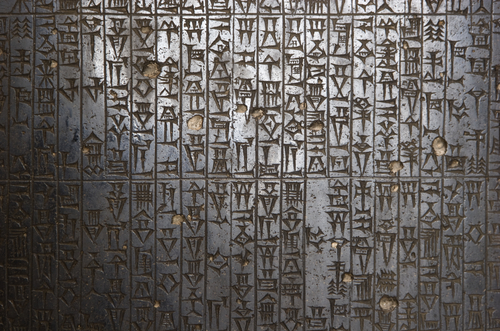The Babylonians were an ancient civilization that thrived in Mesopotamia, present-day Iraq, from the 18th century BCE to the 6th century BCE. They made significant contributions in various fields, including mathematics, astronomy, law, and architecture.
The Babylonians developed a sophisticated number system based on 60, which influenced modern timekeeping and geometry. Hammurabi, one of their notable rulers, established the famous Code of Hammurabi, an early legal code.
The Babylonians were skilled astronomers and builders, constructing grand structures like the ziggurat of Babylon and the Ishtar Gate. Their written language, cuneiform, played a crucial role in documenting their knowledge and culture. The Babylonian civilization left a lasting legacy in the ancient world.
Babylonians Facts
1. Ancient civilization in Mesopotamia (present-day Iraq)
The Babylonians were an ancient civilization that existed in Mesopotamia, the region between the Tigris and Euphrates rivers, which is located in present-day Iraq.
Also Read: Babylonian Empire Timeline
Mesopotamia is often referred to as the “cradle of civilization” because it was one of the earliest regions where complex societies emerged.
2. Advanced knowledge in mathematics and astronomy
The Babylonians made significant advancements in mathematics and astronomy. They developed a sophisticated number system based on 60, known as the sexagesimal system.
Also Read: Accomplishments of the Babylonians
This system, with its multiples and divisors of 60, allowed for more precise calculations and was particularly useful for measuring time and angles. It influenced our modern division of hours and minutes and the division of circles into 360 degrees.

3. Hammurabi created the Code of Hammurabi
Hammurabi, one of the most prominent Babylonian rulers, reigned from 1792 BCE to 1750 BCE. He is best known for creating the Code of Hammurabi, a comprehensive set of laws that covered various aspects of Babylonian society.
The code consisted of 282 laws that addressed issues such as property rights, trade, contracts, family matters, and criminal offenses. It aimed to provide a sense of order and justice and served as a legal framework for Babylonian society.
The code also introduced the principle of “lex talionis” (an eye for an eye), which influenced later legal systems.
4. Skilled astronomers and developed early astronomical texts
Babylonians were renowned for their accomplishments in astronomy. They developed one of the earliest known astronomical texts, called the Enuma Anu Enlil, which documented their observations and knowledge of celestial phenomena.
They tracked the movements of celestial bodies, including the sun, moon, and planets, and recorded them systematically. Babylonian astronomers also made significant contributions to the development of astrology, associating celestial events with earthly events and human destiny.
5. Polytheistic religion with grand temples like the ziggurat of Babylon
The Babylonians were deeply religious and practiced a polytheistic belief system. They worshiped a pantheon of gods and goddesses, attributing different deities to various aspects of life and natural forces.
Also Read: Facts About Ziggurats
Their religious beliefs influenced every aspect of Babylonian society, from government and law to architecture and daily rituals. The Babylonians constructed magnificent temples and ziggurats dedicated to their gods, engaging in elaborate ceremonies and offering sacrifices to seek their favor and protection.
6. Accomplished architects and builders of grand structures
The Babylonians were known for their architectural prowess. The city of Babylon itself was a marvel of construction, with its grand walls and imposing gates.
The most famous of these gates was the Ishtar Gate, adorned with vibrant blue glazed brick reliefs depicting dragons and lions. The Babylonians also built impressive palaces for their rulers and wealthy elites, showcasing their advanced engineering skills and artistic craftsmanship.
The Hanging Gardens of Babylon, often regarded as one of the Seven Wonders of the Ancient World, were another architectural feat attributed to the Babylonians, although their existence remains a topic of debate among historians.

7. Developed cuneiform writing system
The Babylonians developed a writing system known as cuneiform. Cuneiform was one of the earliest writing systems in human history and involved making wedge-shaped marks on clay tablets using a stylus.
It allowed the Babylonians to record a wide range of information, including administrative records, legal documents, literature, and scientific texts.
Cuneiform was written in several languages, including Akkadian and Sumerian, and its decipherment in the 19th century played a crucial role in unlocking the history and knowledge of ancient Mesopotamia.
8. Expertise in irrigation and agriculture
The Babylonians excelled in irrigation and agriculture. They developed advanced systems for managing water resources, including canals, dikes, and reservoirs.
These innovations allowed them to harness the waters of the Tigris and Euphrates rivers for irrigation, which in turn supported a highly productive agricultural sector.
Babylonians cultivated crops such as barley, wheat, dates, and various vegetables. Their agricultural surplus played a vital role in sustaining urban populations and fueling economic development.
9. Active in trade and had a bustling marketplace
Trade was a significant aspect of Babylonian society. The city of Babylon, strategically located on the Euphrates River, became a major hub of trade in the ancient Near East.
Babylonian merchants engaged in long-distance trade, establishing commercial connections with neighboring regions such as Egypt, Anatolia, and the Persian Gulf. They traded a wide range of goods, including textiles, metals, agricultural products, luxury items, and even slaves.
The Babylonian marketplace thrived, attracting traders and travelers from various parts of the ancient world.
10. Reached its peak under Nebuchadnezzar II
Nebuchadnezzar II, one of the most famous Babylonian kings, ruled from 604 BCE to 562 BCE and presided over the Neo-Babylonian Empire. Under his reign, Babylon reached its peak of power and prosperity.
Nebuchadnezzar II undertook extensive construction projects to beautify Babylon, including the aforementioned Ishtar Gate and the grand palace complex known as the “Palace Without Rival.” He also reconstructed the city walls, making Babylon one of the most fortified cities of its time.
Nebuchadnezzar II’s military campaigns expanded the empire’s territory, encompassing a vast region of the ancient Near East. His rule marked a period of cultural and architectural achievements, leaving a lasting impact on Babylonian history.
